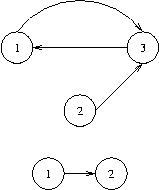POJ2553( 有向图缩点)
The Bottom of a Graph
| Time Limit: 3000MS | Memory Limit: 65536K | |
| Total Submissions: 9779 | Accepted: 4063 |
Description
We will use the following (standard) definitions from graph theory. Let V be a nonempty and finite set, its elements being called vertices (or nodes). Let E be a subset of the Cartesian product V×V, its elements being called edges. Then G=(V,E) is called a directed graph.
Let n be a positive integer, and let p=(e1,...,en) be a sequence of length n of edges ei∈E such that ei=(vi,vi+1) for a sequence of vertices (v1,...,vn+1). Then p is called a path from vertex v1 to vertex vn+1 in Gand we say that vn+1 is reachable from v1, writing (v1→vn+1).
Here are some new definitions. A node v in a graph G=(V,E) is called a sink, if for every node w in G that is reachable from v, v is also reachable from w. The bottom of a graph is the subset of all nodes that are sinks, i.e., bottom(G)={v∈V|∀w∈V:(v→w)⇒(w→v)}. You have to calculate the bottom of certain graphs.
Let n be a positive integer, and let p=(e1,...,en) be a sequence of length n of edges ei∈E such that ei=(vi,vi+1) for a sequence of vertices (v1,...,vn+1). Then p is called a path from vertex v1 to vertex vn+1 in Gand we say that vn+1 is reachable from v1, writing (v1→vn+1).
Here are some new definitions. A node v in a graph G=(V,E) is called a sink, if for every node w in G that is reachable from v, v is also reachable from w. The bottom of a graph is the subset of all nodes that are sinks, i.e., bottom(G)={v∈V|∀w∈V:(v→w)⇒(w→v)}. You have to calculate the bottom of certain graphs.
Input
The input contains several test cases, each of which corresponds to a directed graph G. Each test case starts with an integer number v, denoting the number of vertices of G=(V,E), where the vertices will be identified by the integer numbers in the set V={1,...,v}. You may assume that 1<=v<=5000. That is followed by a non-negative integer e and, thereafter, e pairs of vertex identifiers v1,w1,...,ve,we with the meaning that (vi,wi)∈E. There are no edges other than specified by these pairs. The last test case is followed by a zero.
Output
For each test case output the bottom of the specified graph on a single line. To this end, print the numbers of all nodes that are sinks in sorted order separated by a single space character. If the bottom is empty, print an empty line.

Sample Input
3 3 1 3 2 3 3 1 2 1 1 2 0
Sample Output
1 3 2
题意:给定一幅有向图,若某点所能到达的点也能到达其本身,那么这个点为sink。由小到大输出sink.
思路:有向图缩点得到一棵树,答案为构成叶子(出度为0)结点的连通分量。
#include<cstdio> #include<cstring> #include<algorithm> #include<vector> using namespace std; const int MAXN=5005; vector<int> mp[MAXN]; int n,m; int dfn[MAXN],low[MAXN],time; int stack[MAXN],top; bool ins[MAXN]; int belong[MAXN],cnt; void dfs(int u) { dfn[u]=low[u]=++time; stack[top++]=u; ins[u]=true; for(int i=0;i<mp[u].size();i++) { int v=mp[u][i]; if(!dfn[v]) { dfs(v); low[u]=min(low[u],low[v]); } else if(ins[v]) low[u]=min(low[u],dfn[v]); } if(dfn[u]==low[u]) { int v; cnt++; do{ v=stack[--top]; belong[v]=cnt; ins[v]=false; }while(u!=v); } } int deg[MAXN]; bool flag[MAXN]; void solve() { /* for(int i=1;i<=n;i++) printf("%d\n",belong[i]);*/ for(int i=1;i<=n;i++) for(int j=0;j<mp[i].size();j++) { int v=mp[i][j]; if(belong[i]!=belong[v]) { deg[belong[i]]++; } } for(int i=1;i<=cnt;i++) if(deg[i]==0) flag[i]=true; for(int i=1;i<=n;i++) if(flag[belong[i]]) printf("%d ",i); printf("\n"); } int main() { while(scanf("%d",&n)!=EOF&&n) { scanf("%d",&m); memset(dfn,0,sizeof(dfn)); memset(low,0,sizeof(low)); memset(ins,false,sizeof(ins)); memset(deg,0,sizeof(deg)); memset(flag,false,sizeof(flag)); top=0; time=0; cnt=0; for(int i=1;i<=n;i++) mp[i].clear(); for(int i=0;i<m;i++) { int u,v; scanf("%d%d",&u,&v); mp[u].push_back(v); } for(int i=1;i<=n;i++) if(!dfn[i]) dfs(i); solve(); } }
下面是kosaraju算法
#include"cstdio" #include"cstring" #include"vector" using namespace std; const int MAXN=5005; vector<int> G[MAXN]; vector<int> rG[MAXN]; vector<int> vs; int V,E; int cpnt[MAXN]; int vis[MAXN]; void dfs(int u) { vis[u]=1; for(int i=0;i<G[u].size();i++) if(!vis[G[u][i]]) dfs(G[u][i]); vs.push_back(u); } void rdfs(int u,int k) { cpnt[u]=k; vis[u]=1; for(int i=0;i<rG[u].size();i++) if(!vis[rG[u][i]]) rdfs(rG[u][i],k); } void scc() { memset(vis,0,sizeof(vis)); for(int i=1;i<=V;i++) if(!vis[i]) dfs(i); memset(vis,0,sizeof(vis)); int k=1; for(int i=vs.size()-1;i>=0;i--) if(!vis[vs[i]]) rdfs(vs[i],k++); } int deg[MAXN]; void solve() { scc(); for(int i=1;i<=V;i++) { for(int j=0;j<G[i].size();j++) { int to=G[i][j]; if(cpnt[i]!=cpnt[to]) { deg[cpnt[i]]++; } } } int flag=0; for(int i=1;i<=V;i++) { if(deg[cpnt[i]]==0) { if(flag==0) { printf("%d",i); flag=1; } else { printf(" %d",i); } } } printf("\n"); } int main() { while(scanf("%d",&V)!=EOF&&V) { scanf("%d",&E); vs.clear(); memset(cpnt,0,sizeof(cpnt)); memset(deg,0,sizeof(deg)); for(int i=1;i<=V;i++) { G[i].clear(); rG[i].clear(); } for(int i=0;i<E;i++) { int u,v; scanf("%d%d",&u,&v); G[u].push_back(v); rG[v].push_back(u); } solve(); } return 0; }





【推荐】还在用 ECharts 开发大屏?试试这款永久免费的开源 BI 工具!
【推荐】国内首个AI IDE,深度理解中文开发场景,立即下载体验Trae
【推荐】编程新体验,更懂你的AI,立即体验豆包MarsCode编程助手
【推荐】轻量又高性能的 SSH 工具 IShell:AI 加持,快人一步
· .NET 原生驾驭 AI 新基建实战系列:向量数据库的应用与畅想
· 从问题排查到源码分析:ActiveMQ消费端频繁日志刷屏的秘密
· 一次Java后端服务间歇性响应慢的问题排查记录
· dotnet 源代码生成器分析器入门
· ASP.NET Core 模型验证消息的本地化新姿势
· 开发的设计和重构,为开发效率服务
· 从零开始开发一个 MCP Server!
· Ai满嘴顺口溜,想考研?浪费我几个小时
· 从问题排查到源码分析:ActiveMQ消费端频繁日志刷屏的秘密
· .NET 原生驾驭 AI 新基建实战系列(一):向量数据库的应用与畅想